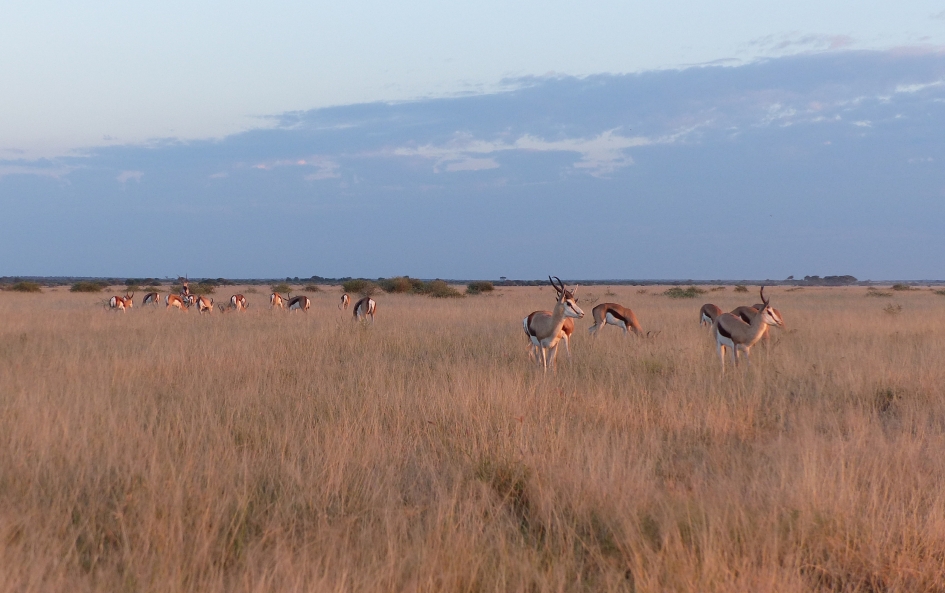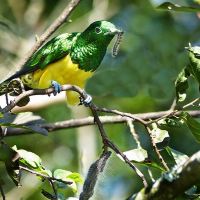A secretarybird with wings outspread and crowned by a stylised rising sun, tops the South African national Coat of Arms. The light, energy and splendour of the sun signifying the rebirth of every day at sunrise, and the soaring flight and power of the secretarybird are intended to inspire confidence and evoke potency.
The secretarybird (Sagittarius serpentarius) is a most distinctive raptor. It has a large eagle-like head and powerful legs. In flight it can soar high like many raptors, but it hunts on the ground walking long distances (typically about 30 km a day) across open plains and grasslands.

This secretarybird shows a high level of concentration as it walks through short grasses in search of food in the Central Kalahari Game Reserve in Botswana
Secretarybirds feed on a variety of small prey, including insects and spiders, birds and their eggs, small mammals such as rodents, amphibians, and reptiles including skinks and small tortoises and also snakes. Contrary to popular belief, snakes do not form the major part of their diet, although they do kill and eat snakes on occasion. When hunting larger or more dangerous prey animals, secretarybirds strike them down and trample them using their powerful legs. It is not true that secretarybirds are immune to snake venom.

The South African national coat of arms, which is topped by the rising sun between the outstretched wings of a secretarybird, also includes within its oval shape a protea flower combined in a diamond shape, a spear and knobkierie that are lying down symbolising peace and also representing the legs of the secretarybird, human figures (derived from the Linton Panel rock painting) greeting in an act of unity, depicted on a shield that in part signifies protection, framed by ears of wheat and two pairs of elephant tusks. The motto !ke e: /xarra //ke (in the Khoisan language of the /Xam people) literally means ‘diverse people unite’. The coat of arms was launched on Freedom Day, 27 April 2000.
For more on the design and symbolism of the national Coat or Arms see https://www.gov.za/about-sa/national-coat-arms

Secretarybirds may be seen foraging alone, more often in pairs and also in small family groups. The male and the female are similar, with the male being a little larger. Pairs are monogamous and it is thought that they partner for life. Here a pair is striding out on the hunt early one morning in the Central Kalahari Game Reserve
Secretarybirds are endemic to much of sub-Saharan Africa occurring particularly in savanna and grassland habitats as well as in semi-desert shrublands and sometimes on agricultural lands where it can be beneficial as a ‘pest controller’. Despite this potential benefit to humans, sadly, in all countries where they occur, numbers are declining rapidly and in the latest global conservation assessment in April 2020 secretarybirds are listed as Endangered in the IUCN Red List.
Threats include loss of habitat as land is converted to residential and commercial development. In agriculture areas, excessive burning of grasslands and intensive grazing by livestock also impacts negatively on the ability of secretarybirds to survive. Other factors contributing to declining numbers of secretarybirds include hunting, poisoning of waterholes, trapping for the pet trade, toxic effects of pesticide use, birds colliding with fences and power lines, and increasing levels of drought.
It would seem that conservation areas remain a last hope for the survival of secretarybirds, as they already are for many of the larger raptors.

This secretarybird is showing the characteristic long plumes at the back of the head and the unusual tail. The long and powerful legs are clad in black ‘breeches’ on the upper legs
It is commonly thought that the English name ‘secretarybird’ is due to the long quill-like feathers at the back of the head, resembling quill pens that a 19th-century European scribe might tuck behind his ear. However, another possibility is that ‘secretarybird’ derives from Arabic saqr-et-tair, which refers to a type of hunting bird (Chittenden et al. 2016: p. 134), but there is no firm consensus on the origin of the English name.
The scientific name also has a complicated history, but suffice to say that Sagittarius serpentarius literally means ‘archer of snakes’. Evidentally, the fact that secretarybirds are cabable of hunting snakes captured the imagination even of taxonomists.

Whatever the origin of the name, the sight of a pair of secretarybirds striding purposefully across open grasslands is unforgettable
And in further reference to the crowning glory of the South African national Coat of Arms, here are some photos taken in conservation areas celebrating the light and life-giving properties of the rising sun.

A bright sun rising over a dry river bed at the Kgalagadi Transfrontier Park

A lioness and two cubs backlit at sunrise at the Kgalagadi Transfrontier Park

A black-maned Kgalagadi lion enjoying early warmth from the rising sun

Looking across the dry pan at Mpayathutlwa at sunrise at the Mabuasehube Game Reserve in Botwana, which forms part of the Kgalagadi Transfrontier Park

A sunrise at Bosobogolo at Mabuasehube Game Reserve, Botswana

Springbok, some grazing and some gazing in the direction of the rising sun at the Central Kalahari Game Reserve, Botswana

Another beautiful sunrise as the day breaks at the Central Kahahari Game Reserve, Botswana

The soft light of dawn and a perching pale chanting goshawk in silhouette at the Mabuasehube Game Reserve, Botswana

Sources
BirdLife International. 2021. Species factsheet: Sagittarius serpentarius
http://datazone.birdlife.org/species/factsheet/secretarybird-sagittarius-serpentarius/text
Chittenden, Hugh et al. 2016. Roberts Bird Guide: Illustrating nearly 1,000 Species in Southern Africa (2nd edition). Cape Town: Jacana.
SANBI. [n.d.] Secretarybird. South African National Biodiversity Institute (SANBI). Animal of the Week. https://www.sanbi.org/animal-of-the-week/secretarybird/
Posted by Carol









August 19, 2021 at 9:44 pm
Great photos and interesting background on the Secretary Bird, Carol. And your final series of rising sun photos to finish. I saw one Secretary bird on our safari… they are very cool looking!
LikeLiked by 1 person
August 24, 2021 at 7:32 pm
Indeed they are very cool birds. Not being a natural morning person, I surprise myself when managing to photograph a sunrise 🙂
LikeLiked by 1 person
August 24, 2021 at 8:10 pm
I hear you! 😉☀️
LikeLiked by 1 person
August 9, 2021 at 6:11 pm
Fascinating bird, and a reminder that some feathered things can be quite imposing even when not flying.
LikeLiked by 1 person
August 12, 2021 at 8:57 pm
They do have a rather regal presence!
LikeLiked by 1 person
August 8, 2021 at 7:48 am
Wonderful post! I have not been honoured to see one of these magnificent birds up close, only in the distance. They are really beautiful. I had no idea they could walk that distance in a day, searching for food. They are truly amazing, and terribly sad they are on the endangered list. The sunrise behind the Acacia (no longer called Acacia) is spectacular. Thanks Carol.
LikeLiked by 2 people
August 9, 2021 at 5:11 pm
Thanks so much. Most often when we see secretarybirds – whether single or in pairs – as soon as we approach they deviate from their path so as to turn their backs on us as they walk steadily away, so getting photos of them walking parallel to us and one even walking towards us seemed very lucky!
So glad you like the sunrise with the Acacia. I was in two minds whether to include it but I thought it said a lot about that golden morning light. I think Acacias will retain their name in most people’s minds and conversations even though officially the name has changed!
LikeLiked by 1 person
August 7, 2021 at 7:37 pm
I love that extraordinary bird! It has character like the shoebill.
LikeLiked by 2 people
August 9, 2021 at 5:07 pm
I have only seen photos of a shoebill – and they certainly do look extraordinary too!
LikeLiked by 1 person
August 7, 2021 at 9:40 am
I have a great fondness for the secretary bird and I now know a great deal more about them. Thanks, Carol! Their conservation status is concerning; this is becoming such a huge problem. (The numbers of many ‘everyday’ british birds have declined alarming.) I was also fascinated by the coat of arms. So much of South Africa embodied in that design!
LikeLiked by 2 people
August 9, 2021 at 5:06 pm
Glad to know that you are also fond of secretarybirds. The decline in bird populations in so many parts of the world is alarming and very sad.
You are right they do manage to pack much of SA into the coat of arms!
LikeLiked by 1 person
August 7, 2021 at 1:45 am
Hello Carol,
I first learned of secretary birds via our nature photographers here who often travelled to different countries in Africa for photography assignments. Such a stunning bird, and on a lighter note (I don’t know if this is correct or not) but I did read that one reason for the name “secretary” is that they often look so busy like real secretaries/office professionals so often are…
Thank you for featuring this unique and beautiful bird. And your photos are stunning. Hope you are continuing to stay safe despite the ongoing challenging time!
LikeLiked by 1 person
August 7, 2021 at 5:14 am
Thanks Takami – it’s true they do look busy in a preoccupied kind of way. Also they can resemble Victorian-era clerks in England with their narrow shanks in breeches,wearing long jackets and their hands folded behind their backs and of course quills tucked behind the ear. I tried to find an illustration depicting such Dickensian-style clerks but couldn’t so I am not sure where I get this notion from!
We are safe thanks. We have our own challenges as do most countries and of course we share in the global challenges of the pandemic and climate change. Sending best wishes to you and your family.
LikeLiked by 2 people
August 6, 2021 at 2:08 pm
The secretary bird does cut an imposing figure doesn’t it.
Thank you for another set of astounding photographs. I can almost smell the veld when I look at them.
LikeLiked by 1 person
August 6, 2021 at 2:24 pm
Oh that is great – the smell of the veld! Makes we want to get out there again before too long.
LikeLike
August 6, 2021 at 5:09 pm
There is nothing quite like it
LikeLiked by 1 person
August 6, 2021 at 10:02 am
Many , many years ago I read about the design process of the RSA crest ( Is that the correct word? ) It was fascinating reading.
LikeLiked by 1 person
August 6, 2021 at 12:59 pm
The design is most interesting both in terms of aesthetic qualities and the chosen symbols that manage to encapsulate so many facets of history and aspiration.
LikeLike
August 6, 2021 at 7:55 am
I remember as a child being fascinated by a picture of a secretarybird I had in a natural history picture book. It’s interesting to know more, though less cheerful to understand its conservation status.
LikeLiked by 1 person
August 6, 2021 at 12:48 pm
How interesting that the secretarybird was fascinating even in the pages of the natural history book you had as a child.
I felt I couldn’t avoid mentioning the plight of these birds. We can be grateful for the conservation areas that do continue to exist.
LikeLiked by 1 person
August 7, 2021 at 7:46 am
Indeed. But it sounds an uphill struggle. I think what appealed to me as a child was the name as much as anything. I felt there should have been a ‘;Just So’ story about them
LikeLiked by 2 people
August 9, 2021 at 5:04 pm
Yes they do seem more than worthy of a ‘Just So’ or similar story.
LikeLiked by 1 person
August 6, 2021 at 5:49 am
I like your timely musings on the national coat of arms, and the implied question of how it relates to the current reality. Love the secretary bird photos. They really are the most striking of birds. Must be a great sight to see, and the sun photos are just wonderful.
LikeLiked by 1 person
August 6, 2021 at 12:46 pm
Thanks Graham, and yes that is the implied question in this post as I wonder how much such carefully constructed symbols do resonate in the everyday lives of real people.
Anyway, the coat of arms provided a great reason to feature secretarybirds and sunrises 🙂
LikeLiked by 1 person
August 6, 2021 at 5:30 am
Another excellent post from you: what a grand idea to combine both secretary birds and the life-giving sun! These birds were seen in abundance in the Mountain Zebra National Park during our recent visit – absolutely beautiful creatures. Despite having seen a wide variety of animals, including a lion, our grandson declared his favourite sighting was the secretary bird for, although he had seen them at The World of Birds, “I have never seen one in the wild”. Such is the magic of their beauty and form.
LikeLiked by 1 person
August 6, 2021 at 12:39 pm
Thanks very much Anne. How lovely to see many secretarybirds at the Mountain Zebra Park – perfect grassy plains there for them to stride through. They are charismatic to see in the wild and it is very touching that your grandson responded to their magic, even though they are not afforded the same high profile as the ‘big five’.
LikeLiked by 1 person
August 6, 2021 at 4:04 am
What an amazing bird. What beauty and aplomb! I simply can’t begin to imagine the thrill of seeing one of these spectacular creatures in the wild. I’ll try not to think about what our species is doing to such splendid characters. I also love the explanation of details in your coat of arms. There’s quite a bit in there to strive for… may it ever be. We could use a lesson in following such a path as well. Probably more so. 🙏
LikeLiked by 1 person
August 6, 2021 at 12:34 pm
Secretarybirds really do live up to all the apt descriptors you grace them with!
The coat of arms does encapsulate much to strive for, and it is appropriately aspirational just about everywhere I should think. Hopefully this is the path that will be chosen …
Thanks Gunta.
LikeLike
August 6, 2021 at 3:37 am
What a beautiful bird, and what meaningful symbolism for the flag. I also love your other photos that show the beauty and diversity of S. Africa. May both continue to thrive.
LikeLiked by 1 person
August 6, 2021 at 12:26 pm
Thank you Tanja – southern Africa is truly blessed with great natural beauty and diversity.
LikeLiked by 1 person
August 6, 2021 at 2:09 am
One day the sun will rise on a South Africa where every bit of symbolism captured in our coat of arms will ring true for all her human and animal citizens.
LikeLiked by 1 person
August 6, 2021 at 12:25 pm
I am sure most South Africans are hoping for the same new dawn.
LikeLiked by 1 person
August 6, 2021 at 1:15 am
A truly handsome bird, I was astonished how far it walks in a day. It would be a great loss to lose such a magnificent species. I pray that humans do what needs to be done to curb CO2 levels, and give our wild brethren the space they require and deserve.
Wonderful photos, too!
LikeLiked by 1 person
August 6, 2021 at 12:24 pm
They are very handsome birds and quite regal is stature and gait. It is very sad that they are endangered, not least from climate change. I am with you on the need to curb CO2 levels. Despite all the evidence and widespread anxiety I am not confident that the powers-that-be will act sufficiently to reduce CO2 levels in a scenario that is becoming increasingly critical.
Thanks Eliza.
LikeLike
August 5, 2021 at 11:32 pm
Interesting post! I had never heard of this bird before. How striking! The animal pics and sunrises are stunning. How wonderful to be able to visit places where these animals are free.
Cheers,
Julie
LikeLiked by 1 person
August 6, 2021 at 11:58 am
Thanks Julie. Yes it is very special to see such animals living free in their natural habitats. It is always a thrill to see secretarybirds.
LikeLiked by 1 person